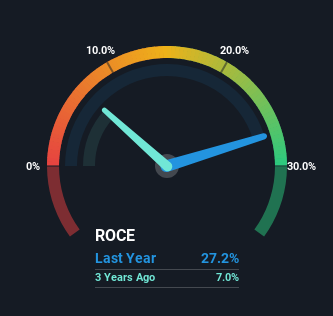If you’re not sure where to start when looking for the next multi-bagger, there are a few key trends you should keep an eye out for. Typically, we’ll want to notice a trend of growing return on capital employed (ROCE) and alongside that, an expanding base of capital employed. If you see this, it typically means it’s a company with a great business model and plenty of profitable reinvestment opportunities. And in light of that, the trends we’re seeing at Dropbox’s (NASDAQ:DBX) look very promising so lets take a look.
What Is Return On Capital Employed (ROCE)?
For those who don’t know, ROCE is a measure of a company’s yearly pre-tax profit (its return), relative to the capital employed in the business. To calculate this metric for Dropbox, this is the formula:
Return on Capital Employed = Earnings Before Interest and Tax (EBIT) ÷ (Total Assets – Current Liabilities)
0.27 = US$443m ÷ (US$2.8b – US$1.2b) (Based on the trailing twelve months to March 2024).
So, Dropbox has an ROCE of 27%. In absolute terms that’s a great return and it’s even better than the Software industry average of 7.2%.
Check out our latest analysis for Dropbox

In the above chart we have measured Dropbox’s prior ROCE against its prior performance, but the future is arguably more important. If you’d like to see what analysts are forecasting going forward, you should check out our free analyst report for Dropbox .
What The Trend Of ROCE Can Tell Us
Dropbox has recently broken into profitability so their prior investments seem to be paying off. About five years ago the company was generating losses but things have turned around because it’s now earning 27% on its capital. In addition to that, Dropbox is employing 29% more capital than previously which is expected of a company that’s trying to break into profitability. This can indicate that there’s plenty of opportunities to invest capital internally and at ever higher rates, both common traits of a multi-bagger.
Another thing to note, Dropbox has a high ratio of current liabilities to total assets of 42%. This effectively means that suppliers (or short-term creditors) are funding a large portion of the business, so just be aware that this can introduce some elements of risk. While it’s not necessarily a bad thing, it can be beneficial if this ratio is lower.
The Key Takeaway
In summary, it’s great to see that Dropbox has managed to break into profitability and is continuing to reinvest in its business. And since the stock has fallen 15% over the last five years, there might be an opportunity here. So researching this company further and determining whether or not these trends will continue seems justified.
One more thing: We’ve identified 3 warning signs with Dropbox (at least 1 which is a bit concerning) , and understanding them would certainly be useful.
If you’d like to see other companies earning high returns, check out our free list of companies earning high returns with solid balance sheets here.
Valuation is complex, but we’re helping make it simple.
Find out whether Dropbox is potentially over or undervalued by checking out our comprehensive analysis, which includes fair value estimates, risks and warnings, dividends, insider transactions and financial health.
Have feedback on this article? Concerned about the content? Get in touch with us directly. Alternatively, email editorial-team (at) simplywallst.com.
This article by Simply Wall St is general in nature. We provide commentary based on historical data and analyst forecasts only using an unbiased methodology and our articles are not intended to be financial advice. It does not constitute a recommendation to buy or sell any stock, and does not take account of your objectives, or your financial situation. We aim to bring you long-term focused analysis driven by fundamental data. Note that our analysis may not factor in the latest price-sensitive company announcements or qualitative material. Simply Wall St has no position in any stocks mentioned.
Valuation is complex, but we’re helping make it simple.
Find out whether Dropbox is potentially over or undervalued by checking out our comprehensive analysis, which includes fair value estimates, risks and warnings, dividends, insider transactions and financial health.
Have feedback on this article? Concerned about the content? Get in touch with us directly. Alternatively, email editorial-team@simplywallst.com




